Physical Address
304 North Cardinal St.
Dorchester Center, MA 02124
The radical surgery of orbital exenteration is occasionally necessary in the management of cancer of the head and neck. For the Otolaryngologist, it will most frequently be due to the spread of a malignant tumor from the adjacent paranasal sinuses or the skull base. Some cancers arising in the skin will also require total or subtotal removal of the orbital contents. Invasive fungal infections are indications for aggressive débridement, sometimes including orbital exenteration. Rarely, a benign but locally aggressive tumor or intractable pain will be an indication.
The most clear-cut indications for orbital exenteration are those involving malignant tumors with no hope of salvaging vision in the affected eye ( Fig. 154.1 ). These situations most often include squamous cell carcinoma and other epithelial malignancies. In the largest reported series of orbital exenteration, squamous cell carcinoma (originating in the sinus, skin, or conjunctiva) accounted for one-third of exenterations. A more recent series found basal cell carcinoma to be the most frequent diagnosis, followed by melanoma and sebaceous cell carcinoma. Conversely, a review of 70 consecutive cases of maxillectomy found that 40% of these patients required concurrent orbital exenteration. Imaging is likely to underestimate the extent of tumor invasion into the orbit, and the decision to proceed may need to be made in the operating room. The recent trend, particularly with squamous cell carcinoma, has been preservation of the orbit except in instances of proven invasion of the periorbita (by frozen section at the time of surgery). In several retrospective series there has been no difference in disease-free survival between patients treated with orbit-sparing procedures and those whose surgery included orbital exenteration.
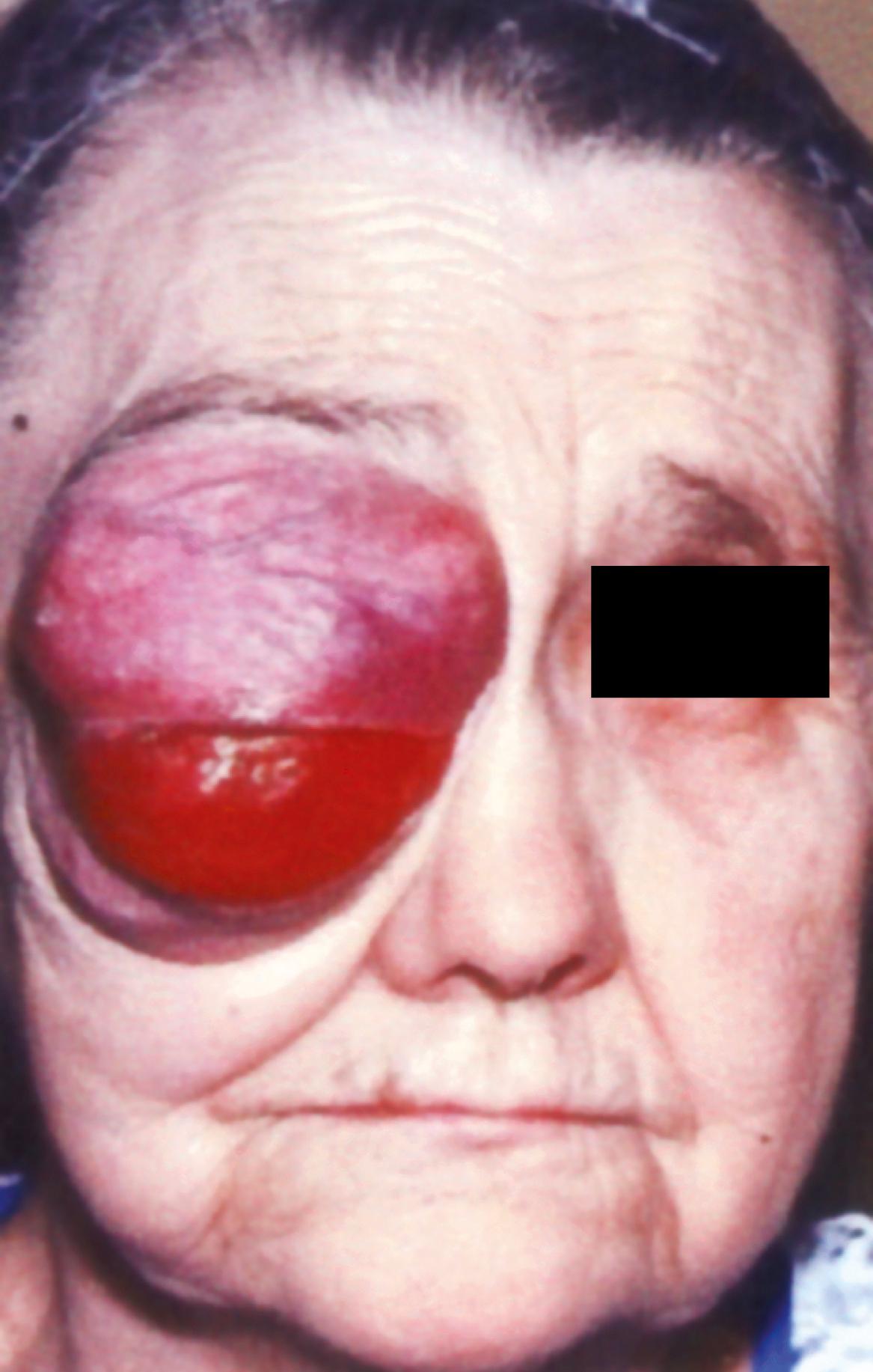
Malignant tumors of the orbit or eyelids, although not strictly invading the eye or periorbita itself, may require removal of the orbital contents because of insufficiency of the remaining tissue for protection of the globe ( Figs. 154.2 and 154.3 ).
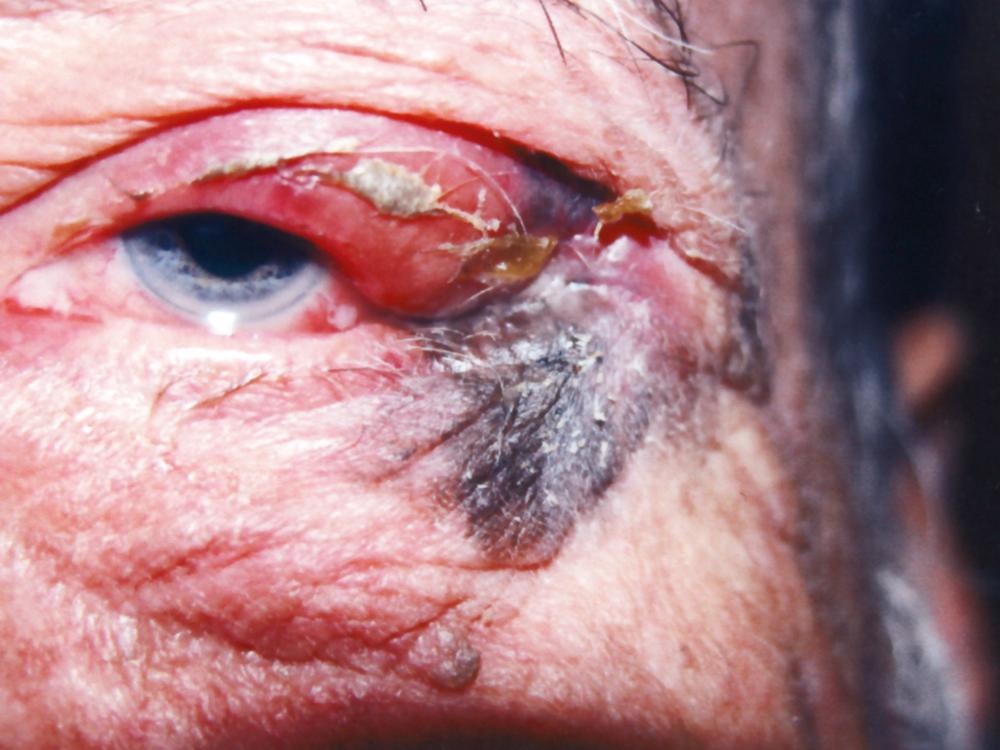
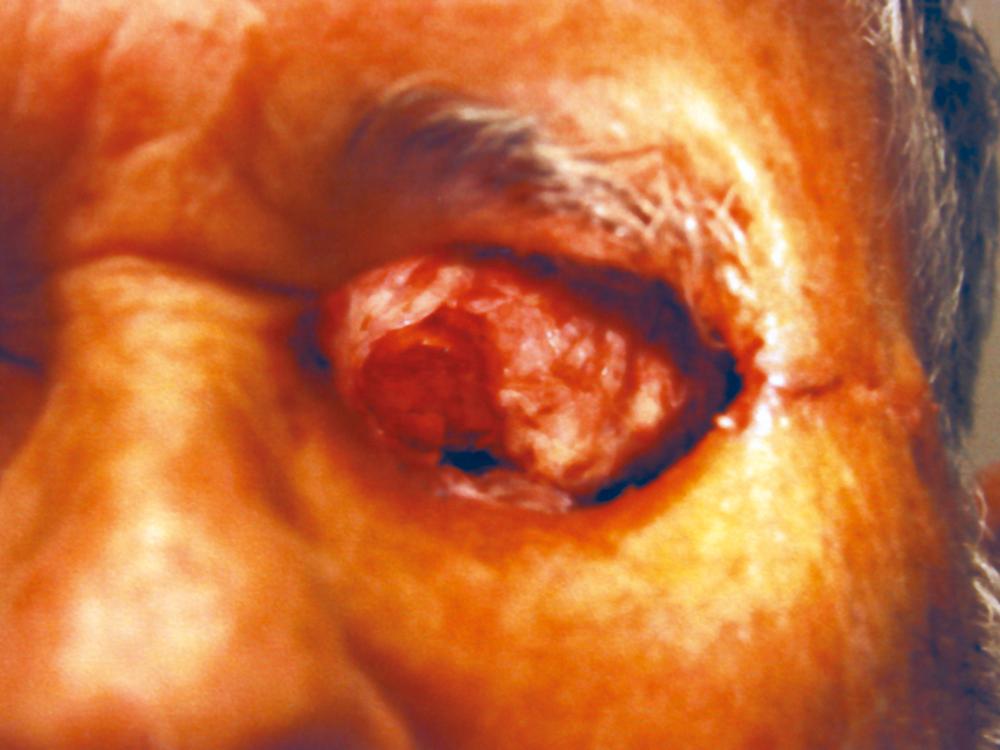
Surgical decision making in the setting of aggressive infection is difficult. Most fungal infections of the orbit spread from adjacent sinuses, and two main types occur. Aspergillus affects both immunocompromised and immunocompetent hosts. In the former patients, the prognosis is extremely poor if the immune status cannot be improved and if intracranial involvement is present. In the latter setting, exenteration is likely to be necessary in cases of apical involvement but not when the infection is confined to the anterior, inferomedial orbit, where limited débridement may suffice.
Rhino-orbital-cerebral mucormycosis is a rare but serious infection caused by Rhizopus species (occasionally Mucor or Absidia ). It affects immunocompromised patients, most often those with a concurrent metabolic acidosis. These patients require aggressive surgical débridement to the level of bleeding tissue, with correction of the underlying medical abnormality. This has frequently included orbital exenteration in the presence of orbital signs, but one series revealed no difference in survival between patients with orbital involvement who underwent exenteration and those who did not. However, the overall mortality in patients with orbital involvement was higher (33% vs. 14%). The operation may be followed by hyperbaric oxygen therapy, which improves survival. A recent review showed 12/14 patients with orbital involvement died of the disease, and the only two who survived had undergone orbital exenteration.
Three to 17% of patients requiring exenteration have benign orbital disease. The various associated diagnoses include inflammatory disease, Stevens-Johnson syndrome, lymphangioma, meningioma, and others. These diseases are either painful, inadequately controlled medically, and “grossly disfiguring” or, although histologically benign, tend to invade adjacent tissue. The pain associated with the disease most often resolves immediately after surgery.
In the practice of most Otolaryngologists, exenteration will be undertaken in conjunction with maxillectomy or during aggressive sinus débridement (e.g., for invasive fungal infection). During the informed consent process, if the decision whether to exenterate the orbit will be made at surgery, it must be made very clear to the patient and family that although every effort will be made to preserve the orbit and eye, this goal will not preclude complete eradication of disease.
Total or subtotal exenteration should be planned. Subtotal exenteration most often means a partially lid-sparing technique ( Fig. 154.4A ), which is appropriate in most cases of benign disease and with tumors that primarily affect the posterior or deep portions of the orbit. It is inappropriate in any tumors affecting the skin, conjunctiva, or lacrimal gland. Lid-sparing exenteration gives an excellent color match to surrounding skin and heals relatively quickly. Globe-sparing exenteration has been described, with purported advantages of easier prosthetic fitting later.
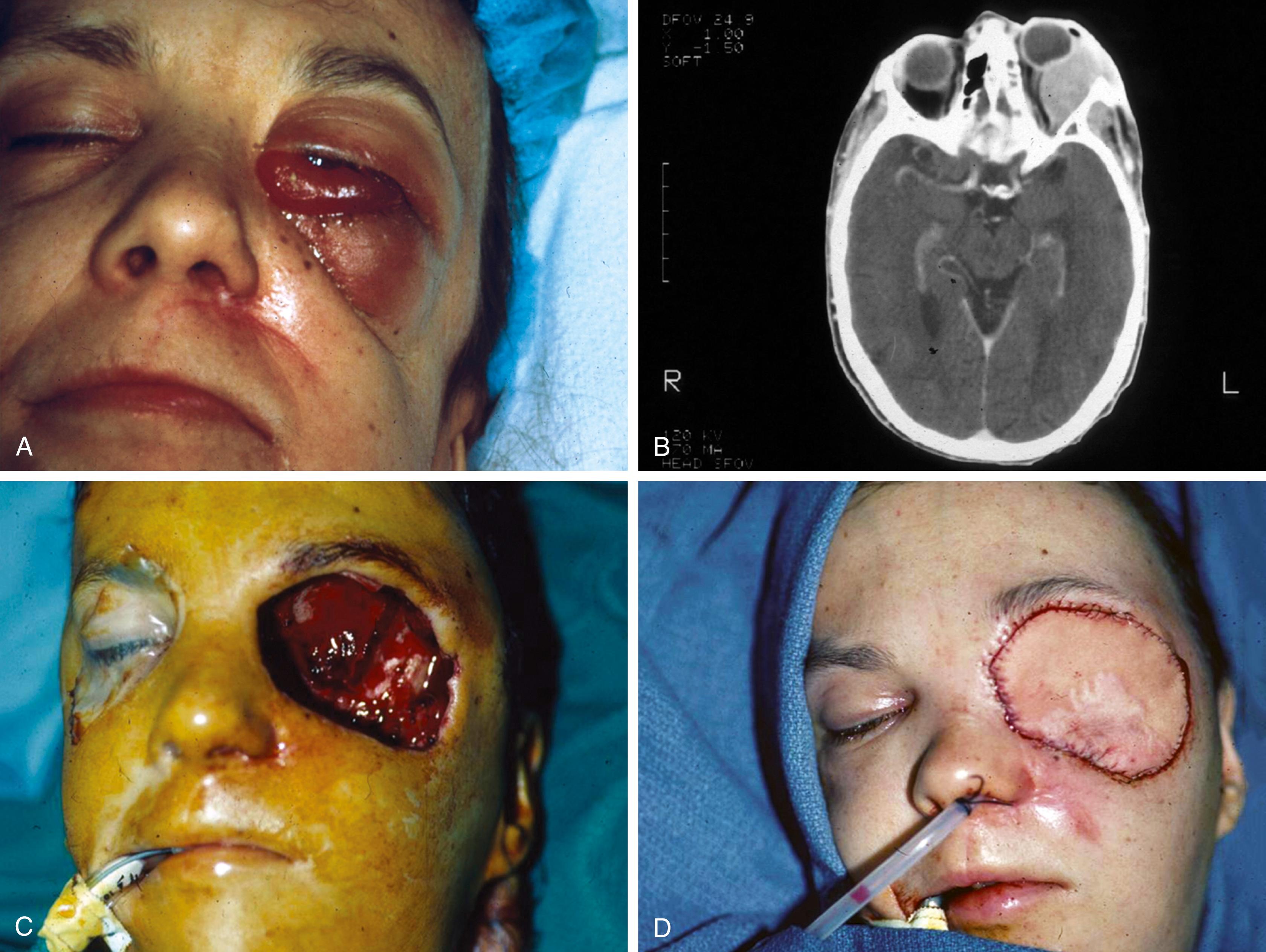
Complete medical history, with attention to:
Previous malignancy
Tobacco use
Infectious disease (human immunodeficiency virus [HIV], human papilloma virus [HPV])
Bleeding disorders
Complete examination of the head and neck focusing on:
Examination of the cervical lymph nodes
Nasal/sinus endoscopy, if indicated
Before scheduling surgery, a complete ophthalmologic examination of the remaining eye is indicated both to guide surgical decision making and to maximize the remaining vision.
Patients who may be candidates for orbital exenteration should, at the very least, be evaluated by computed tomography (CT) or magnetic resonance imaging (MRI) (or both) of the orbits, sinuses (see Fig. 154.4 ), and brain. In the majority of cases that involve malignancy, positron emission tomography (PET-CT) is also indicated.
Patients with invasive fungal sinusitis may have minimal findings on imaging.
When a neck dissection is anticipated, preoperative imaging of the neck and scintigraphy should be considered. The choice of imaging will be guided by the patient’s diagnosis. In patients with malignancies contiguous with the orbit, it is likely that imaging will underestimate the extent of disease, and intraoperative histopathologic monitoring will be necessary.
Malignant tumor of the lacrimal gland
Patients with tumor invasion of the periorbita proven by frozen section examination
Resection of most of the orbital floor frequently leads to loss of integrity of the eye because of dystopia, diplopia, or ocular surface problems. This may be compounded by postoperative radiation effects on the eye.
Invasive fungal sinusitis with orbital invasion
Patients with invasion of orbital bones only will probably have comparable survival if the orbital contents are spared.
Before the operation, coagulation studies, a complete blood count with platelets, and typing and crossmatching of two units of packed red blood cells should be performed.
In many instances, given the radical nature of the surgery, the pathology of the lesion should be independently confirmed by pathologists experienced in the field of head and neck or orbital disease.
Reconstructive options should be considered before surgery.
The simplest option is healing by secondary intention, or granulation. The advantages of such healing are shorter operating time, good color match to surrounding tissue, excellent visibility for monitoring of possible recurrence of disease, and a tendency to produce a shallow socket (easier for eventual patient care). Disadvantages include a long healing time and the necessity for several painful dressing changes.
Split-thickness skin grafts, usually taken from the thigh, are frequently used to line the orbital cavity when total exenteration with removal of periosteum is performed (see Fig. 154.3 ). Although this leads to shorter recovery time and excellent visual monitoring for recurrence, a deeper cavity is formed, for which care and prosthetic fitting are somewhat more difficult. The pain encountered after this reconstructive option is generally from the donor site.
Local or free tissue flaps are most commonly performed at our institution, particularly for defects resulting from concurrent partial or complete maxillectomy. Temporalis muscle, with or without cervicofacial, radial forearm, and rectus abdominis flaps (see Fig. 154.4 ), are most frequently mentioned. These flaps have the advantage of ample tissue and good vascularity, which is desirable in a field likely to require radiation therapy ( Fig. 154.5 ). Disadvantages of longer operating time, donor site morbidity/disfigurement, and a requirement for highly specialized microsurgical techniques (in the case of free flaps) discourage their use in very sick patients. These options also render monitoring for local recurrence of disease more difficult.
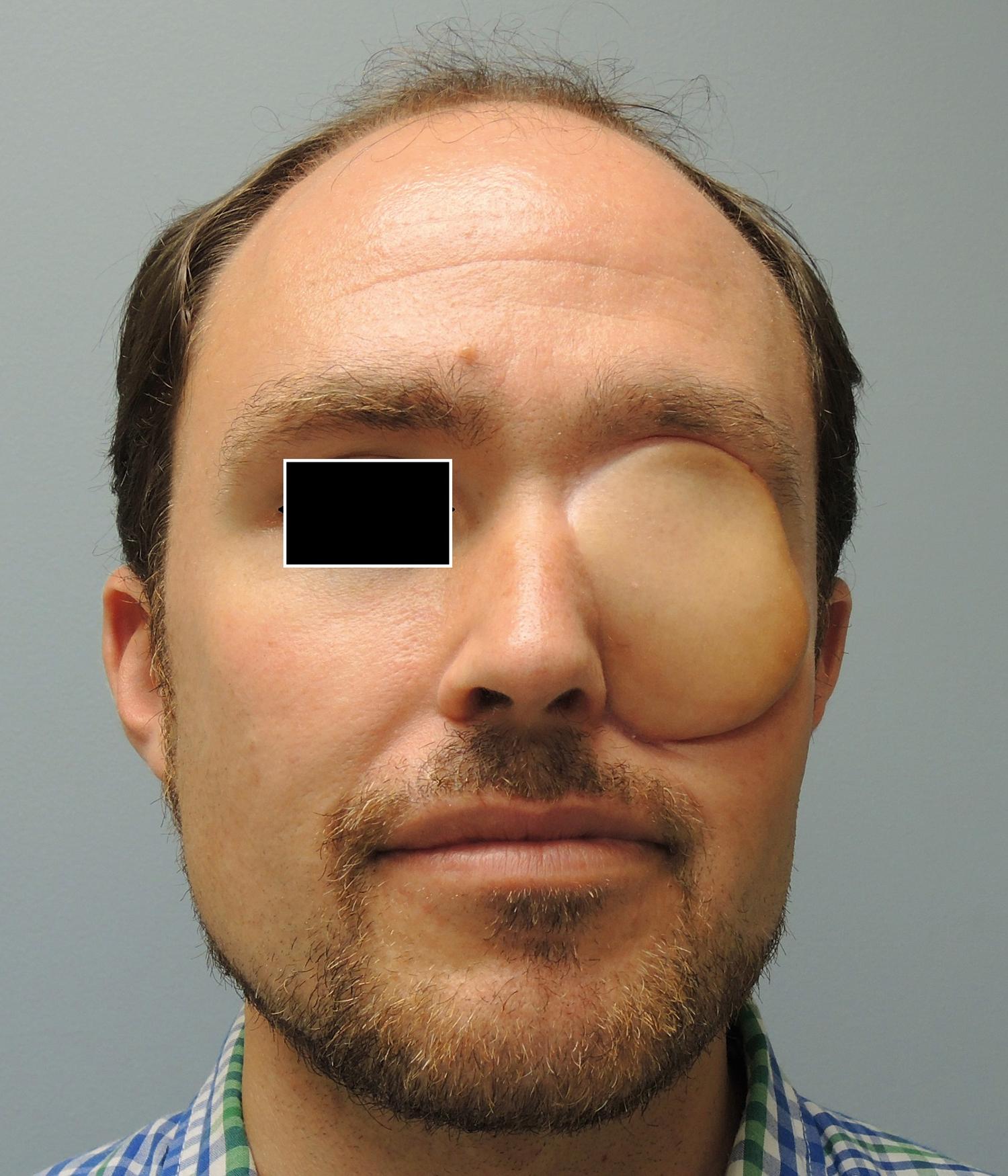
Become a Clinical Tree membership for Full access and enjoy Unlimited articles
If you are a member. Log in here